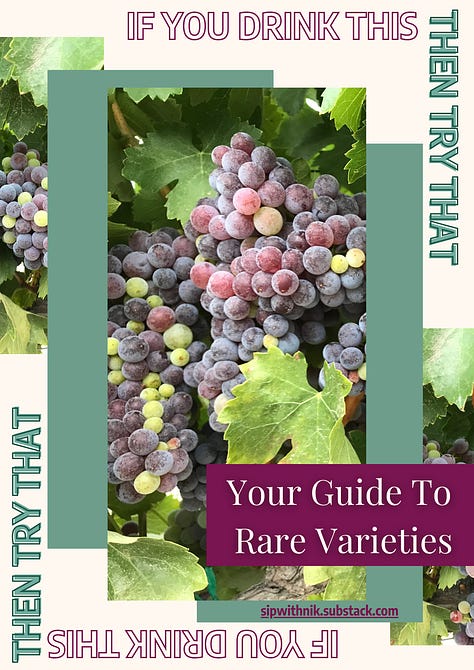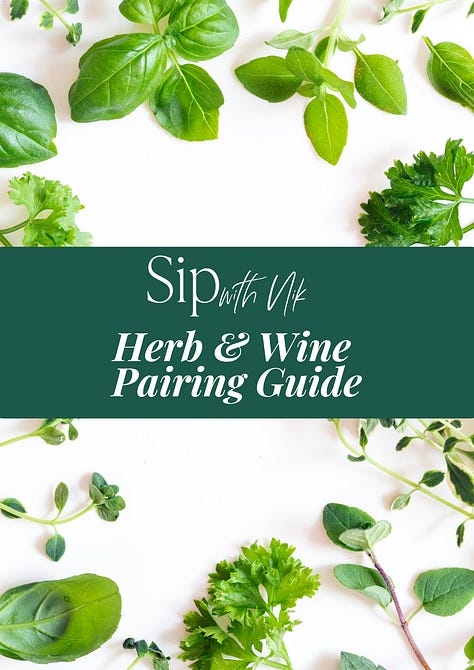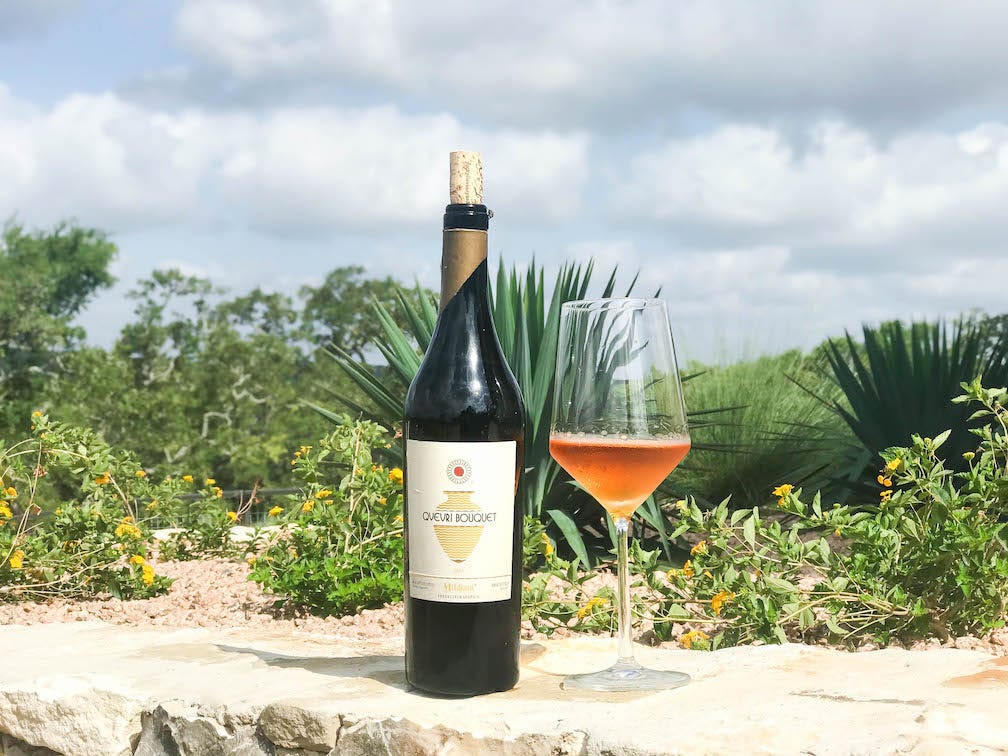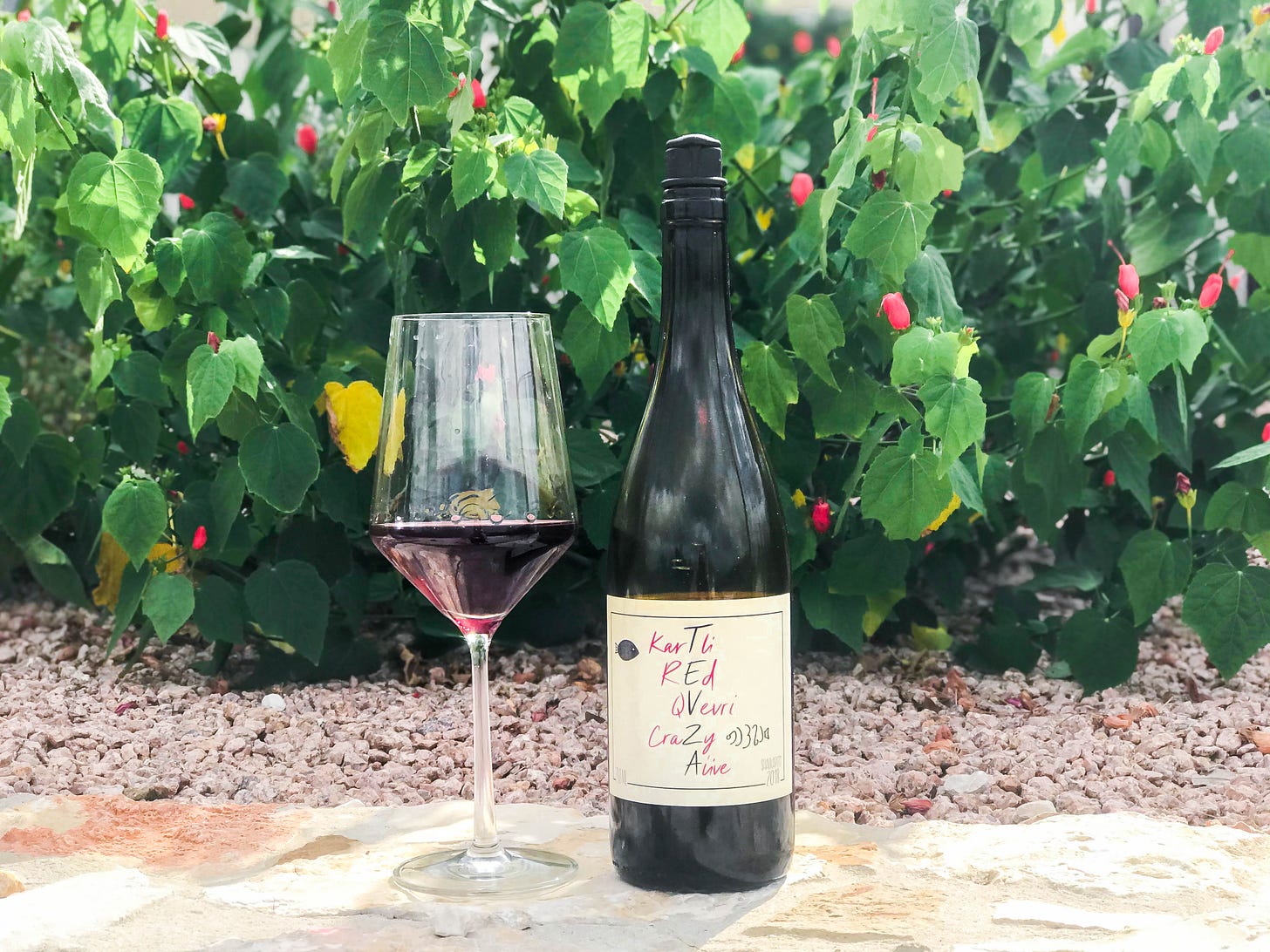Exploring Georgia's Rare Grapes & A Simple Greek Avgolemono Recipe
Journey to the birthplace of wine with ancient Georgian varieties like Tsolikouri, Rkatsiteli, Goruli Mtsvane, and more.
We’re heading to the birthplace of wine for this installment of rare varieties for Try January: Georgia! Nestled at the crossroads of Eastern Europe and Asia, Georgia is bordered by Russia to the north, the Black Sea to the west, Azerbaijan to the east, and Turkey and Armenia to the south. Its ancient winemaking traditions stand out even among its neighbors.
Previously, I highlighted Armenian wines like Haghtanak, Voskehat, Areni Noir, and Kangun. While both Georgia and Armenia share ancient viticultural roots, Georgian wines have their own unique identity. Let’s explore this first through the variety Tsolikouri and a wine from Teliani Valley, one of Georgia’s 20 PDOs. But we’ll begin with a little history.
The History of Wine in Georgia
Winemaking in Georgia dates back 8,000 years. Archaeologists have uncovered grape seeds and vines preserved in ancient clay vessels proving this legacy. According to the Georgian Wines website, Georgia began producing wine 3,000 years before written records and 5,000 years before the Iron Age.
Throughout its history, Georgia faced invasions from powers like the Greeks, Romans, and Persians, often forcing locals to flee their vineyards. In their resilience, Georgians carried saplings with them, preserving native varieties. Today, over 500 unique grape varieties thrive in Georgia, a testament to this determination.
The Georgian Terroir
The Caucasus Mountains dominate northern Georgia, towering 4,000–5,000m high and shielding the country from cold northern winds. To the west, the mountains decline towards the Black Sea, allowing warm, moist air to flow eastward. This creates diverse climates: humid and subtropical in the west, alpine and arid in the east.
Georgia’s soils are mineral-rich, especially near the Black Sea, and its extensive river systems spread nutrients throughout the land. Limestone caves and ancient cave cities dot the landscape, further highlighting its geological richness.
The Variety: Tsolikouri
Tsolikouri, native to western Georgia, has been cherished since the 19th century. Its name translates to “my wife’s wine,” reflecting its endearment. The grape is late-ripening (harvested in late October) and resistant to fungal diseases but sensitive to frost.
Tsolikouri wines are medium- to full-bodied with notes of citrus, florals, and yellow fruits. They’re made in fresh, oaked, and sparkling styles, with the latter two being ideal for aging.
The Winery: Teliani Valley
Teliani Valley Winery, founded in 1997 in Kakheti, is one of Georgia’s largest and most renowned producers. Known for their quality, they’ve been a pioneer in bringing Georgian wines to the American market, earning top scores from Wine Spectator.
Teliani Valley, Tsolikouri 2018
Grapes sourced from the Tvishi micro-zone of Lechkhumi at high altitudes
Medium straw color
Aromas of lemon zest, green apple, and pear
Medium-bodied with zesty acidity and a rounded palate
Notes of green apple and pear linger on a medium finish
Pairing Suggestions
Tsolikouri pairs beautifully with salty, fresh cheeses like feta or paneer. Its vibrant acidity complements dishes like:
Quiche with goat cheese and herbs
Crispy goat cheese poppers
Roasted chicken and potatoes with fresh thyme
Chicken piccata
Scallops in butter and parsley
Traditional Georgian Winemaking Methods
For millennia, Georgians have practiced low-intervention winemaking, relying on spontaneous fermentations in ancient clay vessels called qvevri. In 2013, UNESCO recognized this tradition as vital to humankind’s cultural heritage, adding qvevri winemaking to its “Intangible Cultural Heritage of Humanity” list. Even today, many modern winemakers integrate qvevri into their production processes, blending ancient methods with contemporary techniques.
What Are Qvevri?
Qvevri are egg-shaped clay vessels used to ferment, age, and store wine. These vessels range in size, holding between 20 and 10,000 liters of wine, and are lined with a thin layer of beeswax to prevent bacterial growth.
Winemakers typically bury qvevri underground, using the earth for natural temperature control akin to modern cooling tanks. The tops are sealed to prevent oxidation and contamination. During fermentation, the qvevri’s conical shape encourages yeast and sediment to settle at the bottom while allowing the wine to circulate naturally as carbon dioxide is released.
Georgians: The Original Wine Trendsetters
While modern white wine production typically involves pressing juice off the skins before fermentation, Georgian winemakers traditionally allow skins to macerate with the juice during fermentation, even for white wines. This produces amber-colored wines—known as orange wines—with a tannic structure and complex, evolving flavors.
Amber wines have gained global popularity in recent years, but this winemaking style originated thousands of years ago in Georgian qvevri cellars. Similarly, natural wine—a global trend—has always been integral to Georgian winemaking. Georgians rely on native yeast for spontaneous fermentation and eschew additives, letting the wine evolve naturally.
Rkatsiteli: A Georgian White Variety That Makes Stellar Orange Wine
Rkatsiteli is Georgia’s most widely planted white grape variety, accounting for 43% of all vineyard plantings. Dating back to the 1st century AD, its genetic lineage remains unclear. The name means “red stem,” derived from the Georgian words rka (vine cane) and tsiteli (red).
Native to Kakheti in eastern Georgia, Rkatsiteli is also prominent in Kartli and found throughout the country and beyond.
Rkatsiteli in the Vineyard
Rkatsiteli produces medium-sized, cylindrical bunches with oval berries. It buds in late April and ripens late, usually by late September or early October in Kakheti. Impressively, it sets fruit just three days after flowering.
Growers favor Rkatsiteli for its adaptability and ability to retain acidity while developing high sugar levels. It’s winter-hardy and resistant to downy mildew in eastern Georgia’s dry climate but less so in the humid west near the Black Sea. When dry-farmed, its grape skins develop a pinkish-yellow hue.
Rkatsiteli Vardisperi: A Mutation
In 1948, women harvesting in Mukuzani discovered a pink-berried mutation of Rkatsiteli, later named Rkatsiteli Vardisperi. It produces denser bunches with higher sugar levels and is primarily grown in the Alazani Valley. Wines made from R. Vardisperi are pale-salmon in color, broad on the palate, and lightly spiced.
Rkatsiteli in the Glass
Rkatsiteli wines are crafted using both European techniques and traditional Georgian qvevri methods. European-style wines feature crisp acidity and subtle aromas of florals, citrus, and green apple. Winemakers often block malolactic fermentation to preserve freshness.
In qvevri, Rkatsiteli shines as one of Georgia’s most noble varieties. These amber wines are broad and complex, with flavors of dried orange peel, apricot, honey, caramel, and spices. Depending on skin contact, they exhibit depth, balanced acidity, and a distinctive texture.
Rkatsiteli is often blended with more aromatic varieties like Mtsvane Kakhuri to enhance its profile, as seen in PDOs such as Gurjaani, Tsinandali, and Vazisubani. While most Rkatsiteli wines are dry, PDO Kardenakhi produces sweet wines from this variety.
Soil & Climate in Tsinandali, Kakheti
Tsinandali, located in Kakheti—Georgia’s largest wine-producing region—has a humid, subtropical climate with hot summers and cold winters. The region’s cinnamonic soils, rich in iron and calcium, force vines to develop deep, strong root systems.
The Alazani River flows through Kakheti, shaping the terroir of sub-regions like Tsinandali, Telavi, Gurjaani, and Sighnaghi, where Rkatsiteli thrives.
The Winery: Mildiani Family Winery
Established in 1991 in Tsinandali, Kakheti, the Mildiani Family Winery is run by four brothers passionate about winemaking. Their range includes wines, Georgian brandy, and Chacha. A highlight is their stunning qvevri cellar, showcased in a beautiful video on their website.
Mildiani Qvevri Bouquet Rkatsiteli 2015
100% Rkatsiteli, vinified in qvevri
Amber hue with golden reflections
Aromas of apricot, quince, dried herbs, white flowers, spice, and caramel
Medium-bodied with medium-plus acidity and light tannins
Flavors of orange zest, apricot, and spice
Persistent finish with delicate tannins and savory undertones
Pairing Suggestions
Amber Rkatsiteli pairs beautifully with rich, creamy cheeses like Brie or Époisses. Try it with baked Brie topped with caramelized onions or garlic and herbs. Its structure also complements meat dishes, such as veal chops Milanese with lemon and herbs or herb-marinated lamb chops.
Goruli Mtsvane - The Life of the Party
Goruli Mtsvane is a lively white grape variety native to Kartli, with a name that translates to “green one from Gori,” a village in the region. It also grows in Racha, Meskheti, Imereti, and Kvemo Kartli and is known as Kvishkhura in western Kartli.
Be careful not to confuse Goruli Mtsvane with Mtsvane Kakhuri from Kakheti—they are entirely different varieties. Goruli Mtsvane shines in a range of styles, from still white wines to sparkling and orange wines. The Wines of Georgia website calls it “always the life of the party,” and its vibrant personality lives up to the claim.
Tevza Winery
Tevza Winery was founded in 2018 by Goga Tevzadze in the Kartli region. His micro-winery, complete with a traditional qvevri cellar, is nestled in the village of Saguramo, surrounded by the mountains of Mtskheta.
Goga focuses on crafting expressive, natural wines from Kartli’s native varieties. Using only traditional Georgian methods, Tevza wines reflect the region’s energetic and fresh style. Produced from vines aged 10 to 14 years, these artisanal wines highlight Kartli’s soft, lively character.
Tevza Qvevri Crazy Amber 2018
Goruli Mtsvane grapes crushed directly into qvevri
Spontaneous fermentation with native yeast, followed by natural malolactic fermentation
5 months of maceration and skin contact
Aromas of apricot, honeysuckle, dried orange, olives, and dried herbs
Fresh and lively with delicate tannins, medium body, and well-structured flavors echoing the nose
Pairing Suggestions
Amber wines like Goruli Mtsvane are versatile and bold enough to pair with richly flavored dishes:
Indian cuisine: Perfect with spiced curries.
Moroccan dishes: Complements tagines and bold, aromatic spices.
Asian cuisine: Try it with Korean BBQ, ramen, or Chinese takeout.
The Rare Georgian Gem: Shavkapito
If you enjoy Georgia’s iconic Saperavi grape, you’ll likely love its rare counterpart, Shavkapito. Often described as a lighter, subtler version of Saperavi, Shavkapito has a reputation for being “concentrated, firm and linear, muscular but not a body-builder,” according to The Wines of Georgia book.
Once a widely planted variety in the 19th century, Shavkapito’s cultivation had dwindled to just 10 hectares by 2004. Fortunately, recent efforts by producers like Chateau Mukhrani and smaller growers in its native Kartli region have revived interest in this exceptional grape.
Shavkapito in the Vineyard
Shavkapito is a medium-sized grape variety with conical, winged bunches of moderate density. Its berries are small to medium and display a striking dark blue hue.
This grape has a relatively short growing season. Bud break occurs in late April, with grapes ready for harvest by early September. However, Shavkapito’s early flowering period makes it susceptible to millerandage—a condition where uneven berry sizes develop within a single cluster, leading to uneven ripening and complicating the harvest.
The variety is highly terroir-driven, with vineyard location significantly influencing its flavor profile:
Valley floors and lower elevations produce more intense, full-bodied wines.
Higher elevations and slopes result in lighter, fresher wines with delicate aromas, high acidity, and vibrant fruit notes.
Shavkapito in the Glass
Shavkapito is a versatile variety used to produce red, rosé, and sparkling wines. Winemakers employ both traditional Georgian techniques, like qvevri fermentation, and European-style methods.
Expect wines with a ruby red hue and aromas of cherry, pomegranate, berries, herbs, and a touch of smoke. On the palate, Shavkapito delivers freshness, elegance, and a dynamic balance of fruit and acidity.
Kartli: Climate & Soil
Kartli, Shavkapito’s native region, features a continental climate that is moderately warm and humid, with some drier microclimates. Shida Kartli, where Shavkapito thrives, offers a diverse landscape with varied soils, including:
Lami soil: Meadow-cinnamonic soil first described in Georgia. It has depth, an alkaline pH, low humus, and a loamy texture.
Black chernozem soil: Fertile with high humus content and a clay or loam texture.
Kartli lies within the Eastern Georgia Iveria Intermountain Plain, with Shida Kartli’s vineyards stretching from valley floors to the foothills. This diversity allows for a range of expressions of Shavkapito wines.
Tevza, Kartli Red Qvevri Crazy Alive, Shavkapito 2018
Spontaneous fermentation in 900–1,300L qvevri. 3–4 weeks of maceration on the skins, followed by stabilization in qvevri until spring.
Medium ruby red with brick hues.
Medium-plus intensity notes of grilled black plum, wild blackberry, fresh cherry, and subtle spices.
Medium-bodied with medium-plus acidity, medium-minus tannins, and concentrated flavors of fresh cherry and grilled black plum. Persistent, flavorful finish.
Pairing Suggestions
Shavkapito’s balance of fruit, acidity, and soft tannins pairs beautifully with a variety of dishes:
Georgian cuisine: Eggplant rolls stuffed with goat cheese and walnuts, topped with pomegranate seeds and a yogurt or tahini sauce.
Vegetarian options: Herby barley salad with butter-basted mushrooms or chanterelle mushroom risotto.
Heartier fare: Beef stew with parmesan polenta or chili con carne.
Poultry dishes: Chicken with chanterelle mushroom cream sauce.
Hungry for more? Consider upgrading to a paid subscription for added perks like access to my loaded library of food and wine pairing, wine education, and wine travel guides!







Chkhaveri – A Truly Rare Georgian Variety
Chkhaveri, a native grape variety from the region of Guria in western Georgia, is a hidden gem primarily used to produce rosé wines. Historically, it has also been crafted into white, red, and sparkling wines in both sweet and dry styles. Today, only a handful of Georgian winemakers work with this truly rare variety.
Chkhaveri berries are round, juicy, and thin-skinned, while its clusters are small or conical—sometimes with a single wing. This late-ripening, low-yielding variety is known for its naturally high acidity. The resulting wines are balanced, soft, and moderately alcoholic, with a diverse range of aromas and flavors.
Vine Training Traditions in Guria
Guria, located along the Black Sea coast, has a subtropical and humid climate, making it an ideal region for vine cultivation. However, the humidity poses challenges for late-ripening grapes like Chkhaveri, which are more vulnerable to fungal diseases.
Traditionally, growers in Guria used the maghlari vine training method, where vines were trained to grow up onto trees to improve airflow and reduce humidity-related risks. While maghlari is rarely practiced today, Chkhaveri vines are still trained high off the ground for better ventilation.
Chkhaveri thrives best on south-facing slopes with reduced humidity. It is particularly well-suited to soils with limestone, sandstone, or clay, where it develops its unique character.
Natural Wine Origins: Georgia's Legacy
The Chkhaveri wine featured in this article is a natural wine, continuing Georgia’s ancient tradition of winemaking. While the modern natural wine movement may seem revolutionary, Georgia, the world’s oldest winemaking country, pioneered natural winemaking thousands of years ago.
One of the earliest champions of natural winemaking was Prince Ilia Chavchavadze, often called the “Father of the Nation.” In the late 19th century, Chavchavadze led a revival of Georgian natural wine traditions. In 1887, he published a series of articles—later compiled into a book titled Georgian Winemaking—defending Georgia’s natural techniques against European winemaking criticism.
Chavchavadze believed that winemaking should follow nature’s lead:
“The true purpose of winemaking, its beginning and end, is to make wine naturally following the process by which nature itself transforms grape juice into wine.”
– Prince Ilia Chavchavadze
Dato’s Wine: Honoring Rare Varieties
Dato Kobidze, a winemaker in Guria, is preserving Georgia’s winemaking heritage by crafting expressive natural wines from rare varieties. Working with grapes from his family vineyard near the Black Sea, Dato uses traditional qvevri techniques to create authentic wines that highlight the uniqueness of Georgia’s native varieties.
Dato’s Wine Chkhaveri Rosé 2018
Only 500 bottles made.
Macerated on the skins for 18 days, resulting in a deeply colored rosé.
Aromas of wild berries, fresh acidity, and a textured palate from extended skin contact.
If you’re in the U.S. and interested in exploring more Georgian wines, check out Georgian Wine House. They ship direct to consumer!
Greek Avgolemono: An Easy & Comforting Soup (recipe care of my Greek mama)

Greek avgolemono is easily one of my all time favorite soups. It’s a silky smooth egg (avgo), lemon (lemono), and chicken soup that is so creamy and comforting. In our household, it was the go-to cure for whenever we were feeling sick or just needed something to soothe the soul.
My Yiayia (grandma) would go through the lengthy process of making homemade chicken broth so that the soup was extra flavorful, which you can totally do. However, my mom and I usually opt for using boxed organic chicken broth instead. This shortcut brings cooking time to around 30 minutes for a quick, satisfying meal.
The ratio is 1 egg, 1 lemon, and ¼ cup of rice for every quart (32 oz) of chicken broth. So you can adjust the recipe based on how many servings you need.
You can also buy some bone in chicken breast and boil it in the broth while the rice is cooking or add some chicken bouillon to make the soup extra flavorful.
The key to making silky smooth avgolemono is actually two fold. First, you’ll want to use an electric hand mixer to beat your eggs and don’t just beat them by hand. It really makes a difference in achieving that silky texture for which we’re aiming.
Secondly, be sure to temper the egg and lemon mixture with warm soup before adding the eggs to the pot of soup or else the eggs will curdle and you’ll have scrambled egg soup. We definitely don’t want that.
Ingredients
Serves 6-8
3 qts. Organic chicken broth or stock
3 eggs
3 lemons
¾ cup white long grain rice (Mom always uses Uncle Ben’s)
Chicken bouillon (follow package instructions for measurement ratio)
Instructions
Bring eggs and lemons to room temperature prior to starting.
Bring chicken broth to a boil.
Add your rice and allow to cook until tender; 10-20 minutes depending on what kind of rice you prefer. Add your chicken bouillon (or bone in chicken breast if you’d like) as well.
Once the rice is cooked, turn off the burner and remove the pot from heat. Allow to rest uncovered for 10 minutes to bring the temperature down a bit. (If you added chicken breast, remove it now and shred the meat to put back into the soup.)
Juice your lemons in a measuring cup or small bowl. Crack your eggs into a separate bowl and use an electric hand mixer to beat them. Turn the mixer setting to a lower speed and slowly pour in the lemon juice while still mixing the eggs.
Now you’ll need to temper the egg and lemon mixture. Slowly add a ladle at a time of the warm soup broth while beating the egg mixture on a low speed. Add 3-4 ladles of broth to the egg mixture to bring its temperature closer to the temperature of the soup.
Add the egg, lemon, and broth mixture to the pot of soup while stirring. Return the pot to the burner on low heat and allow the soup to cook for 5 more minutes.







